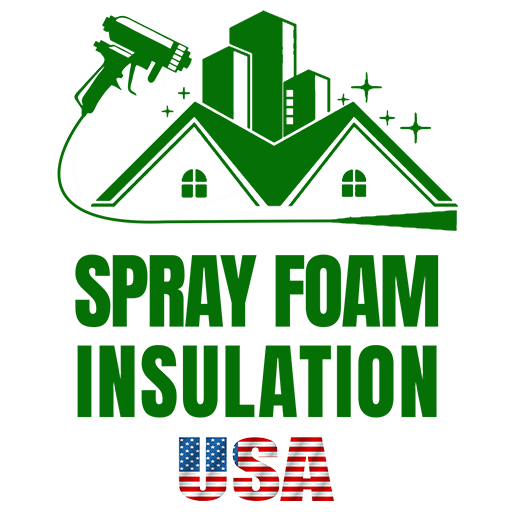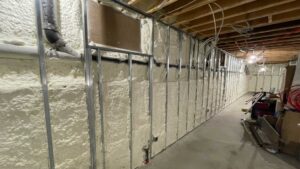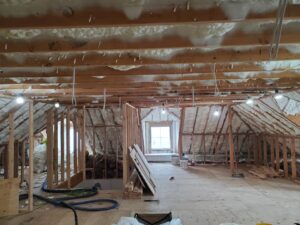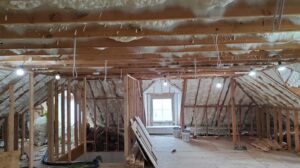Insulation basics and the importance of insulation cannot be overstated. Insulation is your home’s secret weapon for keeping you warm in winter and cool in summer. Without it, you’re just throwing money out the window on energy bills. But here’s the kicker – not all insulation solutions will break the bank.
Quick Answers for Inexpensive Insulation Solutions:
– Expanded Polystyrene (EPS): Most cost-effective with decent R-value.
– Fiberglass Batts: Widely available, easy to install, and wallet-friendly.
– Cellulose Insulation: Great for eco-conscious folks; made from recycled materials.
– Rigid Foam Board: Offers versatility without a huge upfront cost.
– Spray Foam Insulation: Ideal for sealing air leaks and resisting moisture effectively.
If you’re a homeowner or business owner in NY and NJ looking to make your space more energy-efficient without spending a fortune, keep reading. Our aim is to guide you through various insulation materials highlighting their benefits and affordability. By the end of this guide, you’ll be armed with the knowledge to choose an insulation solution that’s not only light on your wallet but also enhances the comfort of your space and your contribution to a greener planet.

Understanding Insulation Materials
When it comes to making your home more energy-efficient and comfortable, choosing the right insulation material is key. Here, we’ll break down the basics of the most popular insulation materials: EPS, Fiberglass, Cellulose, Rigid foam, and Spray foam.
Expanded Polystyrene (EPS)
EPS, or Styrofoam as it’s commonly known, is a lightweight, rigid material that’s easy on the pocket. It’s made of polystyrene beads and has a decent R-value, which measures insulation’s ability to resist heat flow. The higher the R-value, the better the insulation. EPS is great for insulating foundations and under slabs. However, it’s not the top choice for areas prone to moisture since it can absorb water over time.
Fiberglass Batts
Fiberglass is made from fine glass fibers and is one of the most common insulation materials due to its affordability and ease of installation. It comes in batts and rolls that fit snugly between wall studs and ceiling joists. While fiberglass is effective at slowing down the spread of heat, cold, and sound in structures, it can irritate the skin and lungs during installation, so protective gear is necessary.
Cellulose Insulation
Cellulose is an eco-friendly insulation made from recycled paper products, primarily newspaper, treated with fire retardants. It has a higher R-value per inch than fiberglass, making it a superior choice for thermal resistance. Cellulose can be installed as loose-fill or blown-in, making it ideal for retrofitting older homes where it can be added to existing walls without much disturbance.
Rigid Foam Board
Rigid foam offers a higher R-value per inch than fiberglass or cellulose, making it a great option for exterior and interior walls, as well as for insulating basements and crawl spaces. It’s more expensive upfront but can lead to significant energy savings over time. Rigid foam boards are easy to cut and fit into tight spaces, providing excellent resistance to heat flow.
Spray Foam Insulation
Spray foam stands out for its exceptional ability to seal leaks and gaps with a moisture-resistant barrier. There are two main types: open-cell and closed-cell. Open-cell spray foam is lighter and cheaper but has a lower R-value. Closed-cell foam is denser, offers a higher R-value, and adds structural strength to walls. Spray foam is more expensive than other types of insulation, but its superior air-sealing properties can significantly reduce energy bills.
DIY Insulation Tips for Homeowners
While professional installation is recommended for most insulation types, especially spray foam, there are ways homeowners can improve their home’s insulation on a budget. Weatherproofing windows and doors, using thick curtains, and sealing attic entrances can all help reduce energy costs.
Room-by-Room Insulation Guide
- Office: Rock wool for acoustic quality.
- Kids’ Room: Use allergen-free cellulose.
- Living Room: Reflective foil and window insulation for summer heat.
- Garage: Rigid foam for its high R-value.
- Basement: Spray foam for moisture control.
Choosing the right insulation material depends on your specific needs, budget, and whether you’re building new, retrofitting, or just upgrading. The goal is to enhance comfort, reduce energy bills, and contribute to a healthier planet. For those looking for a comprehensive solution, Spray Foam Insulation USA offers a range of services tailored to maximize your home’s energy efficiency.
By understanding the properties and benefits of each insulation material, you can make an informed decision that suits your home and budget. Investing in good insulation pays off in the long run through lower energy bills and a more comfortable living environment.
In the next section, we’ll explore inexpensive insulation solutions that won’t break the bank but will keep your home cozy and energy-efficient.
Cheapest Insulation Solutions
When it comes to keeping your home warm in the winter and cool in the summer, insulation is key. But not all insulation is created equal, especially when it comes to cost and effectiveness. Let’s dive into some of the most affordable insulation solutions that still deliver on performance.
Expanded Polystyrene (EPS)
Cost-effectiveness: EPS is a lightweight, rigid foam commonly used in insulation. It’s known for its low cost and decent R-value, which measures its resistance to heat flow. For homeowners on a budget, EPS offers a balance between affordability and insulation performance.
R-value: While not the highest, EPS’s R-value is respectable and can significantly improve your home’s energy efficiency when installed correctly.
Fiberglass Batts
Affordability: Fiberglass batts are among the most common and inexpensive insulation solutions available. They’re easy to find at any home improvement store and can be a great DIY project.
Installation ease: One of the biggest advantages of fiberglass batts is how easy they are to install. Homeowners can often do the job themselves, saving money on labor costs.
Cellulose Insulation
Recycled material: Made from recycled paper products, cellulose insulation is an eco-friendly option. It’s treated with fire retardants to ensure safety, making it a responsible choice for environmentally conscious homeowners.
High R-value: Despite its relatively low cost, cellulose insulation offers a high R-value. This means it’s very effective at keeping your home warm in the winter and cool in the summer.
Rigid Foam Board
Low starting cost: Rigid foam boards provide excellent insulation and can be used in various parts of your home, from the roof to the foundation. While some types can be pricier, there are options available that offer a good balance between cost and performance.
Versatility: Thanks to its rigid nature, this type of insulation can be cut to fit a variety of spaces, making it a versatile option for tricky areas that might be difficult to insulate with other materials.
Spray Foam Insulation
Air sealing: Spray foam insulation is unique because it expands to fill cracks and gaps, providing an exceptional air seal. This not only helps with insulation but also prevents moisture problems, making it a great two-in-one solution.
Moisture resistance: Unlike some other types of insulation, spray foam is resistant to moisture, which can help prevent mold and mildew in your home. While it’s generally more expensive than options like fiberglass batts or cellulose, its durability and effectiveness can make it worth the investment in the long run.
Each of these insulation solutions has its own set of benefits, from cost-effectiveness and ease of installation to eco-friendliness and high R-values. Whether you’re looking to tackle a DIY project or planning to hire a professional, there’s an affordable insulation option out there that can help improve your home’s energy efficiency and comfort.
Next, we’ll provide DIY insulation tips for homeowners looking to further enhance their home’s energy efficiency on a budget.
DIY Insulation Tips for Homeowners
Making your home more energy-efficient doesn’t have to break the bank. With a few simple DIY projects, you can significantly improve your home’s insulation and reduce your energy bills. Let’s dive into some inexpensive insulation solutions that you can tackle over the weekend.
Weatherproofing
The first step to a warmer home is stopping cold air from getting in. This means sealing up those sneaky drafts around doors and windows.
- Use weatherstripping: It’s cheap and easy to apply. Just stick it around your doors and windows where you feel drafts.
- Caulking: Grab a tube of caulking for any cracks or gaps on the exterior of your home. This is especially important around window frames and doorframes.

Thick Curtains
Believe it or not, your grandma’s heavy curtains can keep you warmer.
- Use thermal curtains: They’re designed to trap heat. During the day, open them to let the sunlight warm your home, and close them at night to keep the heat in.
- DIY tip: If you can’t get thermal curtains, hanging a blanket or even a shower curtain behind your existing curtains can add an extra layer of insulation.
Door Snakes
That draft under the door? It’s literally money escaping from your home.
- Make a door snake: You can easily make one with old socks filled with rice or fabric scraps. It’s a fun project and very effective at stopping drafts.
Chimney Plugs
An open chimney is like leaving a window open all winter.
- Use a chimney balloon: It’s an inflatable device that blocks cold air from coming down your chimney. Just remember to remove it before you light a fire!
Attic Sealing
Heat rises, and if your attic isn’t properly sealed, it’s rising right out of your house.
- Reflective foil: This can be a cheaper alternative to full foam insulation. Staple it to the underside of your roof to reflect heat back into your home.
- Check for air leaks: Use foam sealant on any gaps where air might be escaping. This is particularly important around attic doors or hatches.
By tackling these projects, you can make a noticeable difference in your home’s warmth and energy bills. These inexpensive insulation solutions are not only cost-effective but also doable for most homeowners. Every little bit helps when it comes to insulation. So, grab your caulk gun, weatherstrip, and a few other supplies, and start sealing up your home against the cold.
Moving on, let’s explore how you can insulate different rooms in your home for maximum comfort and efficiency.
Room-by-Room Insulation Guide
When it comes to insulating your home, not every room will have the same requirements. Here’s a simple guide to help you choose the right insulation for each room, ensuring comfort, efficiency, and savings.
Office
Rock wool is the go-to for office spaces, not just for its thermal insulation properties but also for its acoustic quality. It’s perfect for keeping outside noise at bay, so you can focus on your work without distractions. Plus, it’s fire-resistant, adding an extra layer of safety to your workspace.
Kids’ Room
For the kids’ room, cellulose insulation is ideal. It’s allergen-free, making it safe for little ones who might be sensitive to other types of insulation materials. Plus, it’s made from recycled paper, so you’re making an eco-friendly choice. Its high R-value means it keeps the room cozy and warm, perfect for peaceful sleep.
Living Room
The living room is where families gather, and comfort is key. Reflective foil insulation works wonders here, especially if you have large windows. It reflects heat, helping maintain a comfortable temperature year-round. Consider adding window insulation too. It’s an inexpensive solution that can significantly improve your living room’s energy efficiency.
Garage
Garages often double as workshops or storage areas, so proper insulation is crucial. Rigid foam insulation, with its high R-value, is an excellent choice. It’s easy to install and effectively keeps the cold out and the heat in, creating a more usable space regardless of the season.
Basement
Basements are prone to moisture, which can be a challenge. Spray foam insulation offers the best moisture control, sealing nooks and crannies to prevent water vapor from seeping in. It also provides excellent air sealing, keeping your basement dry, warm, and comfortable.
By considering the specific needs of each room, you can choose the most effective and inexpensive insulation solutions for your home. Not only will you improve comfort, but you’ll also see significant savings on your energy bills. The right insulation can transform your home into a cozy haven, room by room.
Where to Buy and How to Install
When it comes to making your home more energy-efficient with insulation, knowing where to buy and how to install your chosen materials are crucial steps. Let’s dive into how you can find insulation materials and the best practices for installation, whether you’re doing it yourself or hiring professionals.
Home Improvement Stores
For those embarking on the DIY route for insulation, home improvement stores are your go-to destinations. These stores offer a wide range of insulation materials, including fiberglass batts, cellulose, rigid foam board, and even spray foam kits. Prices can start as low as $3.95 per square foot, making it a budget-friendly option for homeowners. While the initial cost might seem low, factors like delivery and the tools for installation can add to your total expenditure.
Installation Tips
Installing insulation can range from straightforward to complex, depending on the type of insulation you choose. Here are some quick tips:
- Read the Instructions: This might seem obvious, but each insulation type has its nuances. Following the manufacturer’s guidelines can save you from headaches later.
- Safety First: Wear protective gear, especially when working with fiberglass or cellulose, to avoid irritation or inhalation of particles.
- Seal Gaps First: Before adding new insulation, seal any air leaks with caulk or spray foam. This ensures maximum efficiency from your insulation.
- Measure Twice, Cut Once: Whether you’re cutting rigid foam board or rolling out fiberglass batts, accurate measurements are key to minimizing waste and ensuring a snug fit.
Hiring Professionals
While DIY can save money, certain types of insulation, like spray foam, are best left to professionals. Hiring a trusted local installer ensures the job is done right and can prevent costly mistakes. Look for contractors who:
- Have Insulation Expertise: Experience with your chosen insulation type is crucial for a successful installation.
- Are Vetted and Inspected: Organizations like the Federation of Master Builders offer tools to find builders who meet high standards.
- Offer a Free Home Energy Audit: Some companies, like America Energy Solution, provide audits to identify your home’s specific needs before installation.
When deciding between DIY and professional installation, consider the complexity of the job and your comfort level with the tasks required. Sometimes, investing in professional installation can save more money in the long run by ensuring your insulation is as efficient as possible.
In Summary, whether you’re picking up materials from your local home improvement store or scheduling an installation with a professional, understanding your options and the process can lead to significant energy savings and improved comfort in your home. With the right approach, installing insulation can be a smooth and rewarding project.
Frequently Asked Questions about Insulation
When it comes to insulating your home, you might have a few questions. Let’s tackle some of the most common ones, keeping things straightforward and easy to understand.
What is the most cost-effective insulation material?
Fiberglass insulation stands out as one of the most cost-effective materials. It’s affordable and has a decent R-value, which measures its resistance to heat flow. For those on a tight budget, expanded polystyrene (EPS), also known as Styrofoam, is another wallet-friendly option, though its applications might be more limited compared to fiberglass.
How can I insulate my home cheaply?
Insulating your home without breaking the bank involves a mix of smart choices and DIY efforts. Here are a few tips:
- Seal air leaks around doors and windows with weather stripping or caulking. This is a low-cost way to prevent heat loss.
- Add thick curtains to your windows. It’s an inexpensive method to trap heat during winter months.
- Use door snakes to block drafts under doors. You can easily make them from old socks or fabric filled with rice or popcorn kernels.
- Install window film insulation on single-pane windows. It’s a simple and cheap solution to improve thermal efficiency.
- Consider attic insulation with materials like loose-fill fiberglass or cellulose. Attic insulation can significantly reduce heat loss, and in some cases, blown-in options can be cost-effective.
What are the long-term benefits of proper home insulation?
Investing in proper home insulation pays off in several ways:
- Lower energy bills: By reducing the need for heating and cooling, insulation helps cut down your utility costs.
- Increased comfort: Proper insulation keeps your home warmer in the winter and cooler in the summer, enhancing overall comfort.
- Environmental impact: Less energy consumption means a smaller carbon footprint, contributing to environmental protection.
- Noise reduction: Many insulation materials also serve as sound barriers, creating a quieter and more peaceful living environment.
- Enhanced property value: Well-insulated homes are more attractive to buyers, potentially increasing your property’s market value.
While the initial cost of insulating your home might seem high, the long-term savings, increased comfort, and environmental benefits make it a worthwhile investment. Whether you’re considering fiberglass, spray foam, or another insulation type, ensuring your home is properly insulated is a smart move for any homeowner.
Next up, let’s dive into the energy savings and comfort improvements you can expect with Spray Foam Insulation USA, and why it’s a top choice for homeowners looking for effective insulation solutions.
Conclusion
In wrapping up our guide to affordable insulation solutions, it’s clear that the right insulation can lead to significant energy savings and comfort improvements in your home. And when it comes to choosing an insulation type, Spray Foam Insulation USA stands out as a top choice for homeowners seeking both efficiency and value.
Energy Savings
One of the most compelling reasons to invest in quality insulation, like spray foam, is the potential for energy savings. Proper insulation keeps your home warmer in the winter and cooler in the summer, reducing the need for heating and cooling. This not only lowers your energy bills but also contributes to a more sustainable planet by reducing your carbon footprint. Our customers have reported seeing a noticeable decrease in their energy costs, making the initial investment in spray foam insulation well worth it.
Comfort Improvement
Beyond just savings, the comfort of your living space is significantly enhanced with proper insulation. Spray foam insulation, in particular, creates a seal that blocks drafts, moisture, and external temperatures, maintaining a consistent and comfortable climate inside your home. Whether it’s a blistering summer day or a frigid winter night, spray foam insulation helps ensure that your indoor environment remains pleasant and livable year-round.
Why Choose Spray Foam Insulation USA?
At Spray Foam Insulation USA, we’re dedicated to providing our customers with not just insulation, but a comprehensive energy efficiency solution. Our products offer superior air sealing and moisture resistance, making them an ideal choice for any area of your home. From basements to attics, we’ve got you covered.
Our commitment to customer satisfaction, eco-friendly practices, and offering a range of energy-efficient options set us apart. We understand that every home is unique, which is why we conduct thorough evaluations to identify the best insulation solution for your specific needs. Our expert team ensures that the installation process is smooth, efficient, and tailored to maximize your comfort and energy savings.
In conclusion, investing in quality insulation from Spray Foam Insulation USA is not just about reducing your energy bills or improving the comfort of your home. It’s about making a smart, long-term investment in your property. With the right insulation, you can enjoy a warmer, more comfortable home in the winter and a cooler, more pleasant environment in the summer, all while saving money and contributing to a healthier planet.
Ready to enhance your home’s energy efficiency and comfort? Contact Spray Foam Insulation USA today for a free estimate, and take the first step towards a more insulated, efficient, and comfortable living space.






